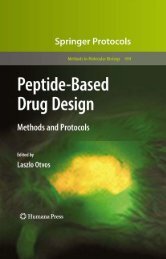Create successful ePaper yourself
Turn your PDF publications into a flip-book with our unique Google optimized e-Paper software.
The Spot Technique 55<br />
solution. Ensure that there are no air bubbles under the surface. Do not shake!<br />
Allow the reaction to occur for at least 5 min. Remove the liquid. Add an appropriate<br />
amount of capping solution with 2% DIPEA. Place the membrane face up<br />
in this solution. Allow the membrane to react with the solution for at least 5 min.<br />
8. Building up the peptide chain: Except for the last coupling cycle, repeat steps<br />
3–11. At the last coupling cycle repeat the above steps without capping and<br />
staining!<br />
9. Final Fmoc-deprotection: Wash four times with DMF for at least 30 s each. Treat<br />
with 20% piperidine/DMF twice for 5 min. Wash four times with DMF followed<br />
by three times with DCM for at least 30 s each.<br />
10. Final side-chain deprotection: Treat the membrane with at least 25 mL of<br />
cleavage solution I for 30 mins. The surface of the membrane must be well<br />
covered by the cleavage solution. Keep the box closed. Do not shake. Pour off<br />
the solution very carefully. Wash the membrane five times with DCM for at<br />
least 1 min each. Treat with at least 25 mL of cleavage solution B for 3 h. The<br />
surface of the membrane must be well covered by the cleavage solution. Keep the<br />
box tightly closed. Do not shake. Pour off the solution very carefully. Wash the<br />
membrane five times for at least 1 min each with DCM. After TFA treatment,<br />
the membrane may become very soft. Do not try to lift the membrane out until it<br />
becomes harder and less likely to break apart during the washing steps (around<br />
the last DCM washing step)! Wash the membrane five times with methanol or<br />
ethanol for at least 1 min each. Dry the membrane in the air stream of a fume<br />
hood or with a hair dryer without heat.<br />
11. Sometimes it may be necessary to use the peptides solubilized and unbound to the<br />
cellulose membrane. If it is necessary to release the peptides from the membrane,<br />
one method is to expose the entire dry membrane overnight in a glass desiccator<br />
containing ammonia gas. The strong basic environment leads to a break of the<br />
ester bond to the cellulose by forming a C-terminal amide (see Note 8). The<br />
next day, punch out the spots and transfer the discs into wells of microtiter plates<br />
(MTPs) or into vials in which you can dissolve and test the released peptides (see<br />
Note 9). If a free carboxy terminal is desired on the peptides, then do not treat<br />
the membrane with ammonia gas, punch out the spots and expose them to a basic<br />
aqueous solution, for example, ammonium hydroxide or sodium hydroxide (26).<br />
Another method is to release the peptide by forming a C-terminal diketopiperazine.<br />
In this case, couple Boc-Lys(Fmoc)-OH instead of the �-alanine spacer<br />
(Fmoc-�-Ala-OH), followed by coupling of Fmoc-proline as the first coupled<br />
amino acid. After TFA treatment the spots can be punched out and transferred to<br />
a MTP or vials (see Note 9). The peptides can be released by overnight treatment<br />
with basic aqueous buffers (pH ≥ 7.5) (1).<br />
3.2. Screening Techniques<br />
In this chapter we present some array techniques to screen for active peptides<br />
(see Note 10). Most of these screening techniques were developed before the






